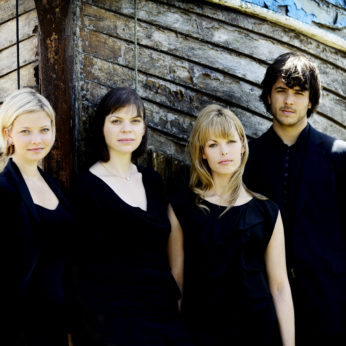Composer: Ludwig van Beethoven (b. 1770 - d. 1827)
Performance date: 08/07/2016
Venue: St. Brendan’s Church
Composition Year: 1809
Duration: 00:30:43
Recording Engineer: Richard McCullough, RTÉ lyric fm
Instrumentation: 2vn, va, vc
Instrumentation Category:String Quartet
Artists:
Chiaroscuro Quartet (Alina Ibragimova, Pablo Hernán Benedí [violins], Emilie Hörnlund [viola], Claire Thirion [cello]) -
[quartet]

The year 1809 was a difficult one for
Beethoven. Napoleon’s brother Jerome offered him the post of Kapellmeister at
Kassel. This caused a panic amongst Beethoven’s supporters in Vienna, who
quickly put together a rival offer of a lifetime annuity designed to keep him
in the city. This was sponsored by the young Archduke Rudolph and Princes Lobkowitz
and Kinsky, who agreed that only one who
is as free from care as possible can devote himself to a single department of
activity and create works of magnitude which are exalted and which ennoble art.
Unfortunately this generous grant was immediately undermined by the
combination of inflation and the occupation of Vienna by French troops.
We
have lately been suffering misery in a most concentrated form. Let me tell you
that since 4 May I have produced little coherent work – practically just a
fragment here and there. The whole course of events has for me affected both
body and soul. What a destructive, disorderly life is here around me, nothing
but drums, cannons, and human misery in
every form. So wrote Beethoven to his publisher
that July. Instead of composing he began preparing composition teaching
material for Archduke Rudolph, who had fled the city. Eventually in August his
inspiration was rekindled and he quickly wrote the Harp Quartet, so-called because of the striking pizzicato effects
in the first movement. It is noticeable that this serene work carries no trace
of the turmoil that Beethoven had been living through.
The contemplative Adagio introduction
prepares the way for the superbly confident Allegro, where the famous pizzicati
soon make their inspiring appearance. The development centres on a wonderfully
exultant treatment of the main theme followed by an extended return to the
recapitulation. The composer Robert Simpson gives a vivid description of the
extraordinary coda as one of the most
original and powerful passages in quartet writing – the first violin breaks out
into brilliant bravura as if he were suddenly the soloist in a concerto, and
while he lets fly the texture thrillingly deepens and solidifies beneath until
the four instruments sound as if the whole world is singing.
The gentle Adagio continues to sing, albeit
in a more melancholy fashion. It is an expansive movement with several themes
and a drawn out coda that only very reluctantly allows the movement to end. The
C minor Scherzo irresistibly reminds us of the same movement in the Fifth
Symphony, the memory reinforced by rushing C major trios. The parallel becomes
even more striking when the scherzo shows signs of imitating the symphony’s
famous transition into the finale. However this is just one of Beethoven’s
jokes and instead of a blazing finale we have a deceptively accented theme
followed by six inventive variations and a sudden allegro coda to bring it all
to an end.
Copyright © 2025 West Cork Music. All rights reserved.
Designed and developed by Matrix Internet